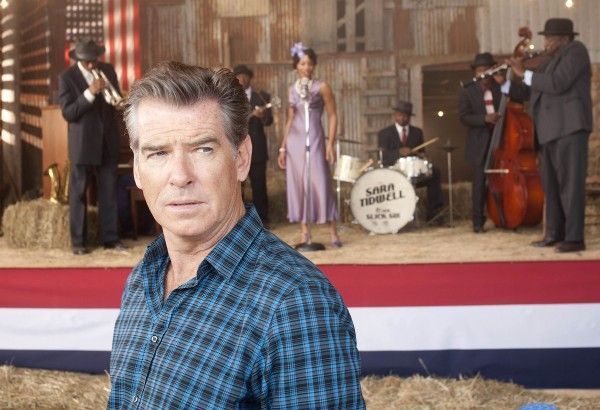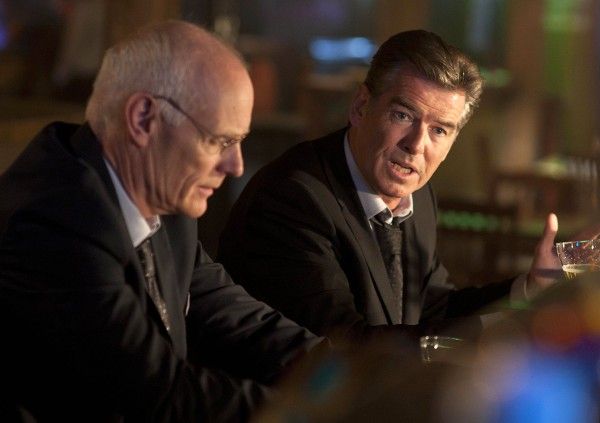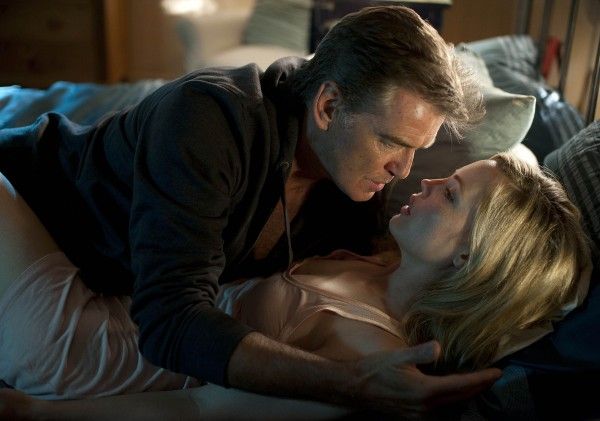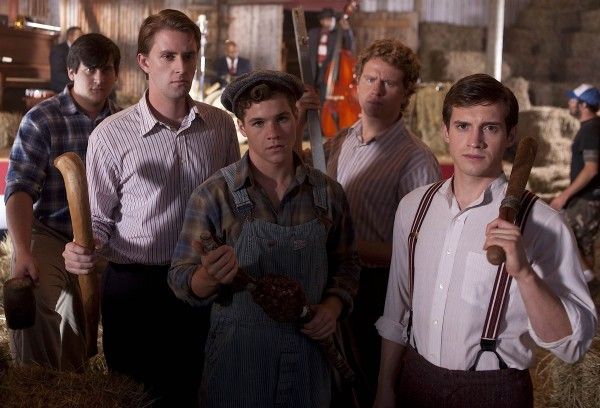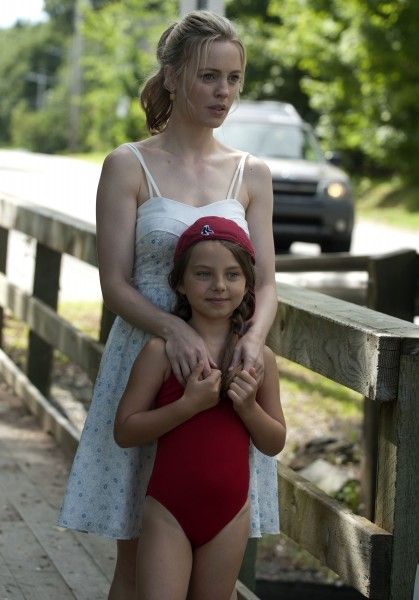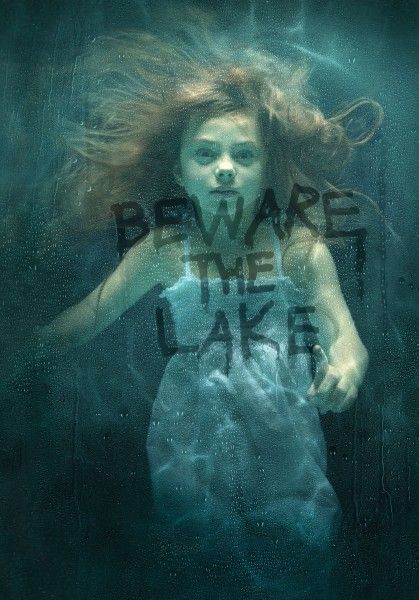The A&E Network mini-series, Bag of Bones, based on the #1 best-selling novel from Stephen King and premiering on December 11th and 12th, is a ghost story of grief and lost love, with an innocent child caught up in the secrets of Dark Score Lake. When best-selling novelist Mike Noonan (Pierce Brosnan) is unable to stop grieving after the sudden death of his wife (Annabeth Gish), he returns to the couple’s lakeside retreat in western Maine, with the hope that it will get him over his current problem with writer’s block. While there, Noonan befriends an attractive young widow (Melissa George) and her daughter (Caitlin Carmichael), and begins having nightmares and mysterious ghostly visitations from blues singer Sara Tidwell (Anika Noni Rose), whose spirit lingers in the house. As everything escalates, Noonan realizes that the town is haunted by many secrets from its dark past.
During this exclusive phone interview with Collider, director Mick Garris talked about what he loves about the Bag of Bones story, why it works better in the mini-series format, the challenges of telling a movie-quality story on a TV budget and schedule, his friendship with Stephen King and why they collaborate so well together, the importance of assembling such a talented cast of actors, and that he hopes viewers really feel the passion of the story. He also talked about wanting to develop one of his own upcoming novellas into a film. Check out what he had to say after the jump:
Question: What makes Bag of Bones one of your favorite Stephen King books, and why did you want to bring that particular story to life?
MICK GARRIS: The very first time I read it, I fell in love with it. There is a period of King’s novel that included this and Lisey’s Story, where they were very internal, they seemed very personal, and they were very passionate. There’s always been a lot of emotion in King’s books, but not a whole lot of romantic passion, and this was one. Around the time that the book came out, I had experienced loss. My mother-in-law had passed away, I’d lost my father and I’d lost two brothers, over the years. That whole idea of loss not really being as entertaining as a horror movie struck me pretty hard. Reading that book, I just loved how it went from passion to loss to sorrow to rebirth, and then to loss, all over again. And, to tell it in the form of a ghost story, I thought was really, really interesting. The whole idea of going back to a past of misogyny and racism, and tying all of that into it, was irresistible to me.
Even though you initially intended for this to be a feature film, were you grateful for the extra time to tell this story, in a mini-series format?
GARRIS: Absolutely! And, that’s been the case. I didn’t think The Stand could have been handled as a feature film. They tried to do it for 15 years, but it’s so enormous. We started with a feature film screenplay that Matt [Venne] had done, and we really had to leave out a lot. It was a little frustrating. It would have made a really good movie, but I think the extra 45 minutes or an hour that we get, by telling it over the course of two nights, really made a big difference. There definitely would have been gaps. Purists to the novel probably will find things that they’re dissatisfied about because they’re not in the mini-series, but we hope that we pulled the slight-of-hand that makes the difference between movies and books not really evident. Books are internal and film is external, and trying to externalize the internal is our job, when you’re adapting a book. So, having two nights instead of one to tell it, was much more gratifying for me, and for Matt as well. The story is complex, in a couple of ways. There’s the complexity of Mike Noonan and what’s going on in his head, for so much in the movie. And then, even more than that, there’s the curse of Dark Score Lake and how he’s tied to it, and clarifying that. It’s very complicated in the book, and we had to streamline that a lot. I think the clarification doesn’t ruin anything, but hopefully strengthens it, when dealing with an audio/visual medium. The marching orders that Matt and I gave ourselves was to make it as clean and direct a line without making it too obvious.
Were there changes that had to be made, in what you could show on television, or do you feel like you were pretty well able to tell the story that you wanted to?
GARRIS: It’s very much the story we wanted to tell and, quite frankly, I did not expect that. There’s some pretty brutal and explicit stuff in the mini-series, even though that’s not what it’s about. But, when we turned in the first cut, with all of that material in it, A&E’s broadcast standards said, “Great.” They asked for no changes. So, even though it’s basic cable where you have advertising supporting it, as opposed to premium cable like HBO or Showtime, it’s still a bit more liberal about censorship then broadcast television. We really bent the rules a lot on ABC with The Stand and The Shining and Desperation, but the attack on Sara Tidwell is pretty explicit, and not necessarily pleasantly explicit. A&E, bless their hearts, did not even blink. We put some care into it because we knew it was going to be on television, but it really was the story we wanted to tell.
How difficult was it to make this movie-quality on a TV schedule and budget?
GARRIS: Well, that’s kind of what I’ve had to do for the length of my career. I’ve never had a giant budget, or a big feature budget. The only features I’ve done have been on the lower-budget end, for what they were. It’s really all about getting the best people aboard and committing to doing the best work possible and prioritizing where your time is going to be spent. I’m glad to hear you say that it’s feature quality because we certainly try to do that. But, I don’t really watch television that much. I love movies. I would do it the same as if I were making a feature film, but it’s just on a more accelerated schedule, so you hire people who are used to doing quality work that are not used to working on a studio schedule. Where they would shoot a page or two a day, we were shooting four or five pages a day. We had a visual effects supervisor who knows how to get a lot for a little, comparatively speaking. We had to work with an entirely Canadian crew because of budgetary reasons, but we got a bunch of people who really wanted to take part in this because they liked the book, they liked the script, they liked the material and they wanted to be a part of it. Not everybody worked for what they normally work for. Our post-production schedule for a four-hour mini-series was very unconventional. We wrapped at the end of September and we delivered it two weeks ago. It was six weeks long, from the time we wrapped to the time we delivered the finished film.
Did you collaborate with Stephen King on this at all, or ask him any questions about the story?
GARRIS: King was not involved as a producer on this, but we’ve been friends for years. I sent him dailies regularly and we did talk, but he’s pretty much a guy who likes to let you do what you’ll do. He learned, a long time ago, of the frustrations of attaching yourself emotionally to a film made from your book that may not turn out well. He’s been able to successfully maintain a balance between the books staying what they are and the movies being what they are, whether he’s involved or not. Any contract with him, he has approvals on a handful of things, and he had director approval, but that was a given because I was involved from the beginning of this. It was just the occasional chat on the phone or emails, or things like that. It was really friendly communication rather than, “You know, you should do this.” He’s not that kind of guy.
What do you think it is about your sensibilities, as a filmmaker, that works so well with his storytelling?
GARRIS: I think we have similar backgrounds, and I am a huge fan of his work and was, long before we ever started working together. I’m old enough to have read The Shining when it first came out, and just was blown away by it. I like that the stories are about human beings first. I’ve been a writer since I was 12 years old, myself. Obviously not a Stephen King level writer, but I’d written short stories and short fiction, from the time I was 12. I’m about to get my second novel published. So, the writing and the storytelling is the important thing, rather than the kills or the creative deaths, or things like that. It’s a fine line. My first teacher was Steven Spielberg. I worked on Amazing Stories. That was my first job, as a writer and as a story editor. Watching him and his command of the tools of filmmaking, and his admiration for writing and the story itself, was the greatest lesson I ever had. A lot of filmmakers have an emphasis on one camp rather than the other. For me, it’s important that a movie is the congregate of all art forms, from writing to art composition to music to performing. Trying to keep a balance of all those is what I think a director’s job is.
A really important part of this film working is the audience wanting to follow Mike Noonan on this journey. What made you decide on Pierce Brosnan to lead this story, and what is it about him, as an actor, that allows people to go on this emotional journey with him?
GARRIS: It was interesting for me because there were a lot of people being talked about, at the time, and I never imagined that Pierce, who is a movie star and hadn’t done television in 15 years, would be interested until he was suggested by his agency, which also represents Stephen King. I loved the idea. First of all, there’s an intelligence about him. You accept that this is a writer. He may not be exactly the guy in the book because he has a touch of an English accent. But, there’s something really great about him that I saw in The Matador, and it’s his willingness to go for it. The best actors in the world are the actors who don’t keep the walls up all the time and allow themselves the potential to be embarrassed. Fighting the wild branches of a haunted tree is not something that every actor is confident enough to attack, literally and figuratively. What I discovered, during the process of this and in my research, was how he can let go of that emotional reserve and, when he does, how powerful it is. When he loses his wife in that scene where he’s lying next to the bed, looking at the pictures of her on his iPad and just breaking down, that is something that not every actor can give you. When we first started talking, he realized what this was about. He’s lost a wife, so it was hard to touch on that stuff, personally. I didn’t want to touch on raw nerves, but he obviously brought those things out in his performance. I just think he’s incredibly powerful in this. You like him. He’s got a sense of humor, he’s really smart, and he’s really vulnerable, in a very real world way.
Was it challenging to find a child actress for the role of Kyra that had the range that you needed?
GARRIS: It was incredibly challenging. We had been reading kids from Toronto, Los Angeles and New York. We were in pre-production in Nova Scotia and we still hadn’t found the right Kyra. There were a couple of them that I was looking at and thinking, “Oh, well, I think she’ll do.” And then, we got in an unsolicited tape that Caitlin Carmichael and her agent had done with an acting coach, doing that scene in the bedroom with Mike Noonan when she’s falling asleep and tells him about the dream that she had about this fair, and I got goosebumps when I was watching it. It was so good. There were no cuts in it, and the changes she went through, from happy to sad to the dream and being haunted by it, were really remarkable and sophisticated for a child that had just turned seven years old. When we finally met and started working together – and I didn’t meet her until she came out to shoot the role – I told her that she was 100 times better than the second best on the list. She’s a really smart, lovable kid who was easy to work with. Without having somebody with that capability, it just would have turned into a TV show. The whole cast is of a level that keeps you from being reminded that you’re watching something made for television.
How challenging was it to tell the Sara Tidwell portion of the story, as far as selecting the right actress, choosing the right songs, and establishing the look and feel of it to really transport viewers to another time period?
GARRIS: That was one of the biggest challenges. Originally, Sony and A&E wanted a pop star. They said, “We want Rihanna. We want Kelly Rowland. We want somebody with big, pop star name value.” And, that was going to be complicated. We went through the motions, but those things take forever and they always say, “No.” And, thank god because it’s a really important acting part and I didn’t want to be an acting teacher. I just wanted to be a director and guide somebody through the part. Actually, it was somebody at A&E that had recommended Anika Noni Rose. I was not familiar with her, but she is a big star on Broadway and has won a Tony Award. I started looking into what she’d done, and I was thrilled with it. And, it turned out that she really wanted to do a movie with make-up in it, and she’s a huge Stephen King fan. Once we started to talk, it happened almost immediately. I cannot imagine anybody better in this part. She’s such a good actress and such a good singer. Because of budgetary reasons, we had to use public domain period songs. I went through all kinds of research and chose those songs and the instrumentation myself. Having been a singer in a band, back in my youth, music is really important to me, so we found these songs that really worked well. My composer, who did the score, brought in musicians to be the band and recorded the sessions with Anika, and I just love them. The Lost Recordings of Sara Tidwell are going to be on iTunes, and you’ll be able to download them.
Because you went on such a long journey with this project, how do you feel about the final product? Did it essentially end up turning out the way you’d always hoped it would?
GARRIS: You never know what it’s going to be. For me, I read the book and knew who the people were, and I had an idea of what it would look like. But then, when you start to find the actual locations that are available to you and you figure out where you’re going to be, it forms in the planning stages. Whatever ends up being the reaction to it, I have no idea what it will be. But, I’m really happy with how the film turned out. I love the performances. I’m really happy with how it looks and the atmosphere and the music. You never know. When you’re really close to a project, you just don’t know. For example, Riding the Bullet was something I was really close to and was really personal, and it was a disaster. Nobody saw it. The reviews were, at best, half and half. Nobody seemed to get what the movie was about. I’ll get emails from people who talk about how important it was to them, personally, but if you’re an artist or you work in media for public consumption, you’re making something to communicate with an audience and the only way you know is when the feedback happens, whether it’s the ratings or reviews, or a combination of both. But, I’m really proud of this and I’m really happy with how it turned out. It’s got an emotional level that I was really hoping for. It’s haunting and personal and passionate. I usually choose a key word for every production, so that every department can focus in on where we’re going, and passion was the key word for this one. Hopefully, that’s been achieved.
Do you have any idea what you’re going to be doing next?
GARRIS: You don’t always get to choose what you’ll be doing, but I’ve got some projects that I’m working on. I’ve got a couple books that are coming out this summer, both of which are novellas. One of them, I’d really like to turn into a film. It’s a ghost story that takes place in Britain. And, there are a couple of things that I’ve been working on, but I also just want to keep my eyes and ears open. It’s nice to have something that’s getting the attention that Bag of Bones is, but who knows where that will lead. I’m ready to see what’s there. It’s been six months of being compressed and living in this project because the pre-production, post-production and production were all incredibly accelerated, so it’s been living and breathing the Mike Noonan story. It’s exciting not knowing what I’m doing next, but it won’t be long before I’m going to feel like I needed to be doing something, whatever it is.

